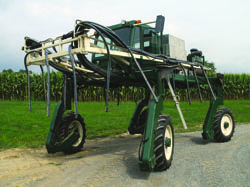
Seeding cover crops into standing row crops is easy with this new "high boy" seeder built by Charles Martin and his sons. With its on-the-go adjustable height and width, hillside leveling, and multiple tracking, Martin's seeder offers features not found in any commercial field machine on the market.
"We needed a better way to seed cover crops on our hilly ground," says Martin, a dedicated no-till farmer. "We built the seeder and used it last year. We made some changes and are using it a lot this year."
What Martin built is a 22 ft. long high boy power unit with a 14 ft. long frame that can stretch from 102 in. to 132 in. in width. It can also raise itself from 6-ft. clearance to 9 1/2 ft. and do that on all four wheels or on one side or the other. The 45-ft. air boom is adjustable in height and pitch to follow the contour of the land.
An 85-hp Deere industrial engine powers the machine. The hydraulics system it drives consists of an Eaton 2500-psi hydrostatic pump with two in-line hydraulic pumps and a 35-gal. reservoir.
While a local hydraulics shop produced all the hoses and fixtures, nearly everything else, including the reservoir, was made by the Martins. They designed the system and installed it.
The hydraulic system drives the wheel motors, raises and lowers the frame, and raises and pivots the boom. Cylinders also control the width of the machine to match row widths or to narrow the machine for transport or driving between fields.
"The sides each narrow 15 in.," explains Martin. "At its widest, it can straddle four 30-in. rows. To load it on our gooseneck trailer, we bring both sides in."
The hydraulic system drives the wheel motors, raises and lowers the frame, and raises and pivots the boom. Cylinders also control the width of the machine to match row widths or to narrow the machine for transport or driving between fields.
"The sides each narrow 15 in.," explains Martin. "At its widest, it can straddle four 30-in. rows. To load it on our gooseneck trailer, we bring both sides in."
The wheel mounts are also hydraulic accumulators that provide suspension and up to 3 1/2 ft. of lift. Each side can be raised independently for leveling on a side hill, or the entire machine can be adjusted in height to match the crop.
The 4-WD uses a flow divider front to back and side to side to ensure constant traction. For example, should the left rear wheel come off the ground or lose traction, a differential lock engages on the right, front wheel.
It's the three-mode wheel control that is amazing. There are no mechanical controls between the wheels, only hydraulics. The seeder is capable of 4-wheel steering, so it can track perfectly on turns with the rear wheels following the front wheels exactly. On hillsides where the back end of any machine tends to drift down hill, the wheels can be set so the rear wheels are slightly offset uphill from the front wheels.
"We have mirrors on the cab that let us look down at the rear wheels and adjust as needed," explains Martin. "We can also disengage rear wheel steering all together."
The air seeding system and the four-way adjustable boom are also quite impressive. Martin used a Deere seed impeller and seed flutes from a drill. Everything else, including the blower, seed bin, and the manifold, was built in their shop. The seed drops out of the bin, through the flute and into a mixing cup where it enters an air stream that carries it to its exit point on the boom.
The 45-ft. boom has a 102-in. center section with two 18-ft. wings that fold back against the frame when not in use. A triangular brace hinged to the front frame of the seeder ends in a ball joint at the boom. Hydraulic arms at either side of the frame can raise and lower the entire boom or pivot the boom.
"If we are on a side hill and have leveled the frame, the downhill end of the boom could be 15 ft. in the air and the uphill side hitting the ground," explains Martin. "This allows the boom to always be parallel to the ground."
Besides seeding their own cover crops, Martin and sons do custom work for others up to 90 miles from their Loysville, Penn. farm. Interest is building in the machine, says Martin.
"The first year we used it, no one showed much interest," he recalls. "This year we are being asked to do quite a few fields and plots."
While the family is interested in building the units to sell, pricing is yet unknown.
"We would need to do some fine tuning and locate component providers," says Martin. "We're waiting to see what the response is. If we could get orders for ten a year, it might be worth it."
